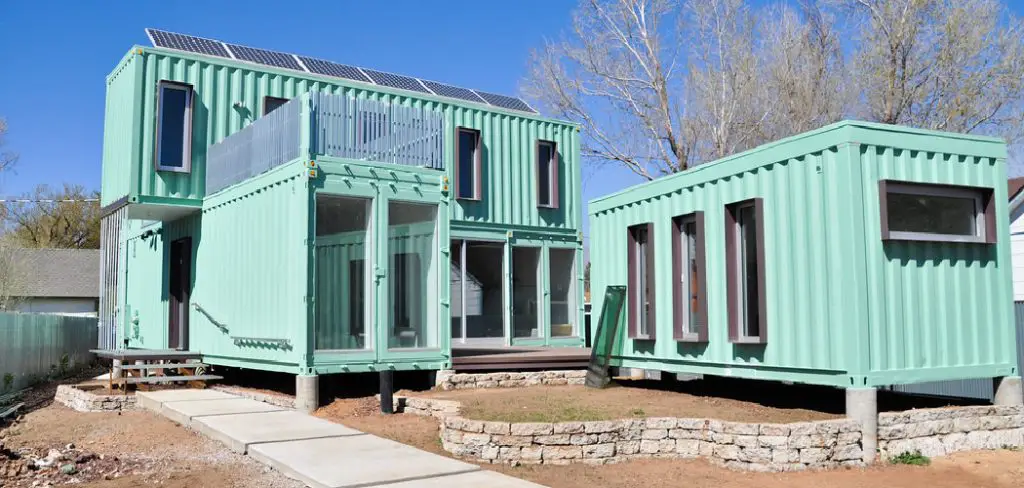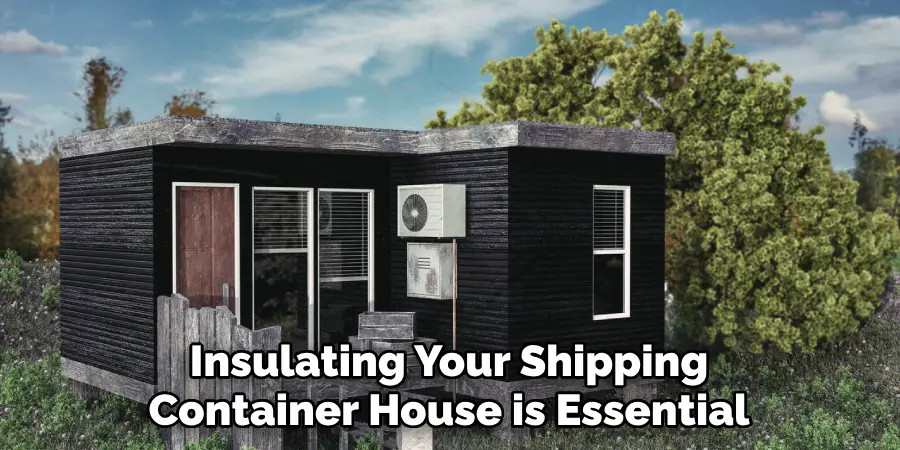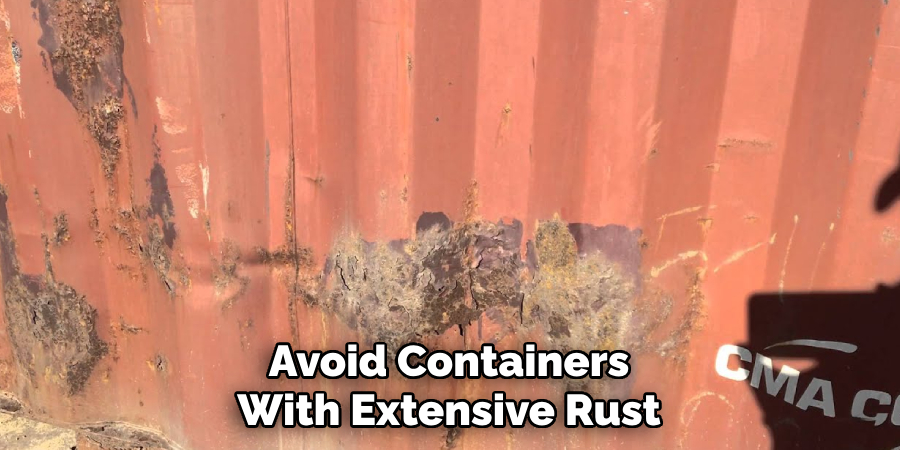Dreaming of a life off the grid? If you want to break away from expensive rent and traditional living, look no further than building a shipping container house! By constructing your home out of cargo containers, you can create an affordable place that offers both environmental sustainability and unique design potential.

Shipping container house building has become a popular trend in recent years, with people worldwide embracing this innovative approach to home construction. This method of building also allows for more flexibility in terms of location, as shipping containers can be transported anywhere by truck, train, or ship.
With careful planning and creative problem-solving, you can fit all the comforts of modern living into these sturdy steel boxes for an exciting new kind of green housing. This blog post will show you how to build a shipping container house!
What Will You Need?
Before you get started, here’s a list of materials and equipment that will be necessary for your shipping container house build:
- Shipping Containers: The first thing you’ll need is the actual containers themselves. These are available in different sizes and can often be purchased or rented at affordable prices.
- Tools: You’ll need various tools, including welding equipment, cutting torches, drills, grinders, and saws, to cut and modify the containers.
- Insulation: Insulating your shipping container house is essential to regulate temperature and reduce noise levels. Options for insulation include spray foam, rigid foam boards, or even natural materials like straw bales.
- Foundation: As with any home build, a solid foundation is essential. You can use a traditional concrete foundation or opt for more eco-friendly options like gravel, pier blocks, or helical piles.
- Utilities: You must consider how you will access electricity, plumbing, and heating/cooling systems in your shipping container house. This may include hiring professionals to lay out the necessary connections.

Once you have these essentials in place, it’s time to start building your shipping container house!
10 Easy Steps on How to Build a Shipping Container House
Step 1: Design Your Home
The first step to building any home is creating a design. With shipping containers, there are endless possibilities for layout and customization. Some popular options include stacking multiple containers for a multi-story home or creating an open floor plan by removing walls and adding large windows.
Step 2: Obtain Necessary Permits
Before construction begins, checking with your local authorities regarding building codes and permits is crucial. Depending on your location, specific rules and regulations may be in place for constructing shipping container homes. Ensure your home design complies with these standards, and apply for the necessary permits. Remember, this step is vital to avoid potential legal issues down the line and ensure the safety and legality of your home.

Step 3: Prepare the Site
Once your permits are secured, it’s time to prepare the building site. This involves leveling the ground, laying the foundation, and arranging to deliver your shipping containers.
The foundation should be prepared according to your chosen design, whether it’s a concrete slab, pier blocks, or helical piles. You’ll also want to plan for adequate drainage around the site to prevent water accumulation and potential damage to your new home.
Step 4: Place the Shipping Containers
With the foundation prepared and the site ready, it’s time to place the shipping containers on the foundation. This step requires precision and often the help of professionals. The containers are carefully lifted and placed onto the foundation using a crane or large forklift.
Additionally, it’s crucial to ensure that all containers are perfectly aligned and level. Misalignment can cause structural issues and complications during the build process. Once securely in place, they can be welded together to form a stable structure.
Step 5: Modify the Containers
After securing the containers, the next step in building your shipping container house is to modify them according to your design plan. This can involve cutting out sections for doors, windows, or interior spaces using a plasma cutter or angle grinder. Any modifications should be done carefully to maintain the structural integrity of the containers.
After the modifications are complete, it’s essential to treat any cut surfaces to prevent rust. This is also the stage where you would install any additional framing needed for interior walls or to support custom features like sliding doors or skylights.
Step 6: Insulate the Containers
Insulating your shipping container home is imperative to create a comfortable living environment, regardless of outside weather. Depending on your climate and budget, various insulation options are available. Spray foam insulation is popular for its excellent thermal resistance and ability to seal gaps and cracks, preventing drafts.
Consider using natural materials like wool or cotton insulation for a more eco-friendly solution. Pay special attention to insulating the roof and the floor to maximize energy efficiency. Remember, proper insulation keeps your home warm in winter and cool in summer and significantly reduces energy costs.

Step 7: Install Utilities
The next step in building your shipping container home involves the installation of utilities, including plumbing, electricity, and HVAC systems. If you need to become an experienced professional, hiring licensed contractors is often best. You’ll need to plan for bathrooms, kitchens, and laundry facilities for plumbing, considering both hot and cold water supply and sewer connections.
Electrical work involves wiring the entire house, installing outlets, and setting up the main control panel. Installing heating and cooling systems will depend on your climate and desired comfort level.
Step 8: Install Interior Walls and Ceilings
After the utilities are successfully installed, it’s time to build the interior of your shipping container home. This step includes constructing the walls and ceilings inside the containers. Drywall is a popular choice for interior walls due to its smooth finish and easy installation.
Alternatively, you could opt for plywood or reclaimed wood for a more rustic look. Ceilings can be constructed using similar materials, and this is also the stage where you can install any lighting fixtures. Once the walls and ceilings are in place, they can be painted or finished to match your aesthetic vision.
Step 9: Install Flooring and Finishings
With the interior walls and ceilings in place, the next step is to install flooring and finishings. Choose a flooring material that suits your style and the home’s overall aesthetic. Common choices include hardwood, laminate, tiles, or polished concrete for a more industrial look.

It’s also essential to ensure the flooring is durable and easy to clean, particularly in high-traffic areas. Finishings such as baseboards, window and door trim, and other details should also be added. Consider using eco-friendly materials or reclaimed wood for a unique and sustainable touch.
Step 10: Exterior and Landscaping
The final step in building your shipping container home is to work on the exterior and landscaping. Exterior finishes are essential for both aesthetic appeal and weatherproofing. You might paint the containers, clad them with another material, or let them rust for an industrial look.
Consider adding a deck, porch, or patio to extend your living space outdoors. Landscaping is also pivotal in making your new house feel like a home. Planting trees, shrubs, or flowering plants not only enhances the visual appeal of your property but it also helps with the home’s energy efficiency by providing shade and reducing heat absorption. Remember, the exterior of your house should be a reflection of your style as much as the interior is.
Following these steps and paying attention to detail, you can successfully build your own shipping container house. It’s an innovative and sustainable way to create a unique living space that meets your needs and reflects your personality.
5 Additional Tips and Tricks
- Plan Your Budget: Before starting, have a clear budget and stick to it. Unexpected costs can and will occur, so it’s wise to set aside contingency funds.
- Know Your Local Building Codes: Every municipality has its codes and restrictions. Familiarize yourself with these before starting your project to avoid costly and time-consuming issues.
- Choose Your Containers Wisely: Not all containers are created equal. They come in various sizes and conditions, so select the ones best suited to your design and quality requirements.
- Invest in Good Insulation: This must be balanced. Sound insulation is vital for maintaining a comfortable interior temperature and decreasing utility costs.
- Think Green: Incorporate sustainable materials and energy-saving technologies wherever possible. This can include solar panels, rainwater collection systems, and recycled or eco-friendly materials for interior finishes.
With these tips in mind, you’re well on your way to constructing your very own shipping container house. Good luck and happy building!
5 Things You Should Avoid
- Avoid Poor Planning: One of the biggest mistakes when building a shipping container house is not having a detailed plan. Work on a comprehensive blueprint that includes all aspects of the design and construction process. Don’t forget to plan for waste management and storage needs.
- Don’t Skimp on Container Quality: Used containers can have varying conditions. Avoid containers with extensive rust or damage, as these can create structural problems down the line. It’s worth investing in high-quality containers for a sturdy and durable home.
- Avoid Inadequate Ventilation: Shipping containers are metal boxes that can become excessively hot or cold. Ensure your design includes ample ventilation and window placements for a comfortable living environment.
- Remember the Roof: Many people need to pay more attention to the importance of the roof. Avoid using the original container roof as your only protection from the elements. Consider installing an additional roof or a protective coating to increase longevity and improve insulation.
- Avoid Unrealistic Expectations: Building a container house is a significant project. Remember to consider the time, cost, and effort it takes. Have realistic expectations and stay prepared for potential setbacks during the building process.

By avoiding these common mistakes, you can ensure a smooth and successful build of your shipping container house. Keep in mind that building with containers requires careful planning, but the end result is a unique and eco-friendly home that you can be proud of.
5 Different Design Ideas
- Minimalist: Keep it simple and sleek with a minimalist design. Utilize clean lines, neutral colors, and open spaces to create a modern living space.
- Industrial: Embrace the industrial look by leaving the exterior of your containers unaltered or painting them in bold colors. Incorporate exposed metal elements and rustic finishes for an edgy and unique design.
- Rustic: Create a cozy and inviting atmosphere with a rustic design. Use reclaimed wood, warm colors, and natural textures to bring a touch of nature into your shipping container home.
- Eco-Friendly: Make your container house as sustainable as possible by incorporating renewable energy sources, recycled materials, and eco-friendly finishes. This design is environmentally conscious and can save you money on utility costs.
- Multi-Unit: Stack and connect multiple containers to create a multi-unit living space. This design is ideal for families or those looking for a larger home while still maintaining the unique and modern look of shipping containers.

The possibilities are endless when it comes to designing a shipping container house.
Are Shipping Containers Heat Proof?
Shipping containers are made of steel, which makes them highly conductive to heat. This means that they can become quite hot during the summer and cold in the winter if not properly insulated.
However, with proper insulation, shipping containers can be highly energy-efficient and maintain a comfortable interior temperature year-round. Investing in suitable insulation materials and techniques is essential when building a shipping container house for optimal thermal performance is essential. To answer the question, shipping containers are not inherently heatproof, but with proper insulation and ventilation, they can provide a comfortable living space.
Building a shipping container house requires careful planning, attention to detail, and innovative thinking. But with the suitable materials, techniques, and mindset, you can create a unique and sustainable home that is truly one-of-a-kind.
Conclusion
Now that you have the skills and information it takes to build a shipping container house, you can make your home from the ground up, just like all of our forebears once did. Following our step-by-step guide will give you the confidence and conviction to take on this ambitious project yourself. Don’t be afraid to take on something new – you might even discover that it’s nothing as intimidating as you first thought!
Hopefully, this guide on how to build a shipping container house has provided you with valuable insight and inspiration for creating your shipping container house. Remember to plan carefully, choose your materials wisely, and stay true to your personal style.
So go ahead, build your dream home! Let us know how things are progressing so we can cheer you on as you take each step in making your very own shipping container house. Good luck!
